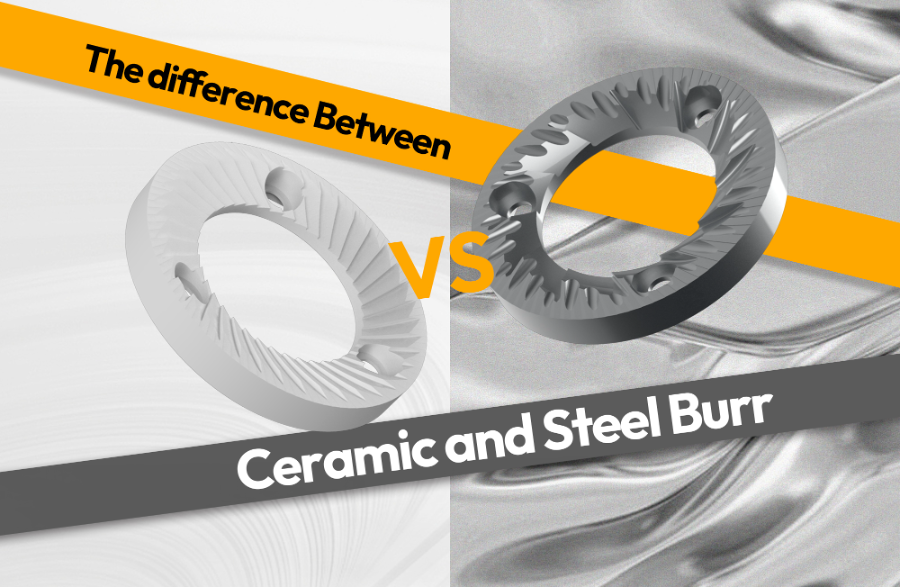Understanding the Difference Between Ceramic and Steel Burr

Introduction

When it comes to making great coffee, how you grind your beans plays a huge role in the final flavor. Coffee grinders typically use two types of materials for their burrs: ceramic and stainless steel. Each has its own strengths and weaknesses, which can affect the way your coffee tastes and how long your grinder lasts. This guide will explain the key differences between ceramic and steel burr grinders in a way that’s easy to understand, helping you choose the best one for your coffee needs.
Ceramic Burr Grinders: What Makes Them Special?
Ceramic burr grinders are known for their durability and the ability to stay sharp for a long time. Made from tough ceramic material, these burrs don’t wear out as quickly as steel burrs, so you don’t have to replace them as often. They also generate less heat when grinding, which is important for keeping the coffee’s flavors intact. This makes ceramic burrs a great option for espresso lovers who want a fine, consistent grind without overheating the beans.

Figure 1. Ceramic Burr
Another benefit is that ceramic burrs resist rust, so they stay clean even in humid environments. However, one downside is that they can be more fragile than steel. If a hard object, like a small rock, gets into the grinder, ceramic burrs are more likely to crack or break. While this doesn’t happen often, it’s something to keep in mind.
Stainless Steel Burr Grinders: Why They’re Popular
Stainless steel burr grinders are the most common type found in both home and commercial grinders. They are tough, durable, and can handle heavy use. Steel burrs are also less likely to crack or break if something hard enters the grinder. This makes them a popular choice for people who use their grinder frequently or in busy environments like coffee shops.
Steel burrs are also generally more affordable than ceramic burrs. However, they tend to wear out faster, so you may need to sharpen or replace them more often. Another thing to consider is that steel burrs can generate more heat during grinding, which might slightly affect the flavor of the coffee, especially for fine grinds like espresso.

Figure 2. Steel Burr
One standout in the steel burr category is LeBrew’s HyperBurrs. These premium burrs are equipped with an advanced AlTiN coating that enhances both durability and sharpness. Among them, the grinding life of 64mm burrs can reach 2000kg. The AlTiN coating reduces heat transfer during grinding, preserving the natural flavors of the coffee beans. Whether you’re brewing espresso or French press, LeBrew HyperBurrs offer a superior grind experience.
Key Differences: A Quick Comparison
|
Factor |
Ceramic Burrs |
Steel Burrs |
|
Grind Quality & Consistency |
Best for fine grinds (e.g., espresso), more precise and sharp for longer periods |
Capable of delivering consistent grinds across the full range, from fine espresso to coarse French press |
|
Heat Transfer & Flavor |
Low heat transfer, preserves delicate coffee flavors |
Higher heat transfer, may affect flavor slightly, especially for fine grinds |
|
Durability & Maintenance |
Long-lasting sharpness, but more fragile, prone to breaking if mishandled |
Durable and resilient, though dulls faster, LeBrew 64mm HyperBurrs can grind up to 2000kg of coffee |
|
Cost & Convenience |
More expensive upfront but lasts longer, with fewer replacements needed |
More affordable, but requires more frequent replacement due to faster wear |
Conclusion
Choosing between ceramic and steel burr grinders depends on your personal preferences and how you brew your coffee. Ceramic burrs are great for people who want fine, consistent grinds and long-lasting sharpness. However, they can be fragile and are more expensive upfront. Steel burrs, especially high-end options like LeBrew HyperBurrs, provide durability, versatility, making them suitable for a wide range of brewing methods.
By considering your budget, the type of coffee you make, and how often you use your grinder, you can decide which burr material is the best fit for your needs. Both ceramic and steel burr grinders can deliver great results, so it all comes down to what works best for your brewing style and preferences.



